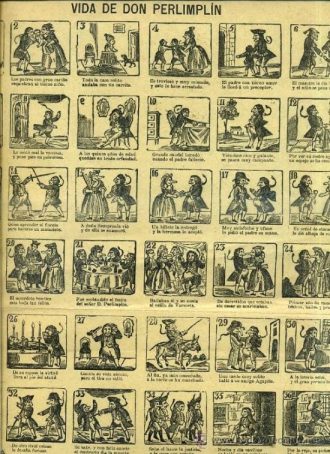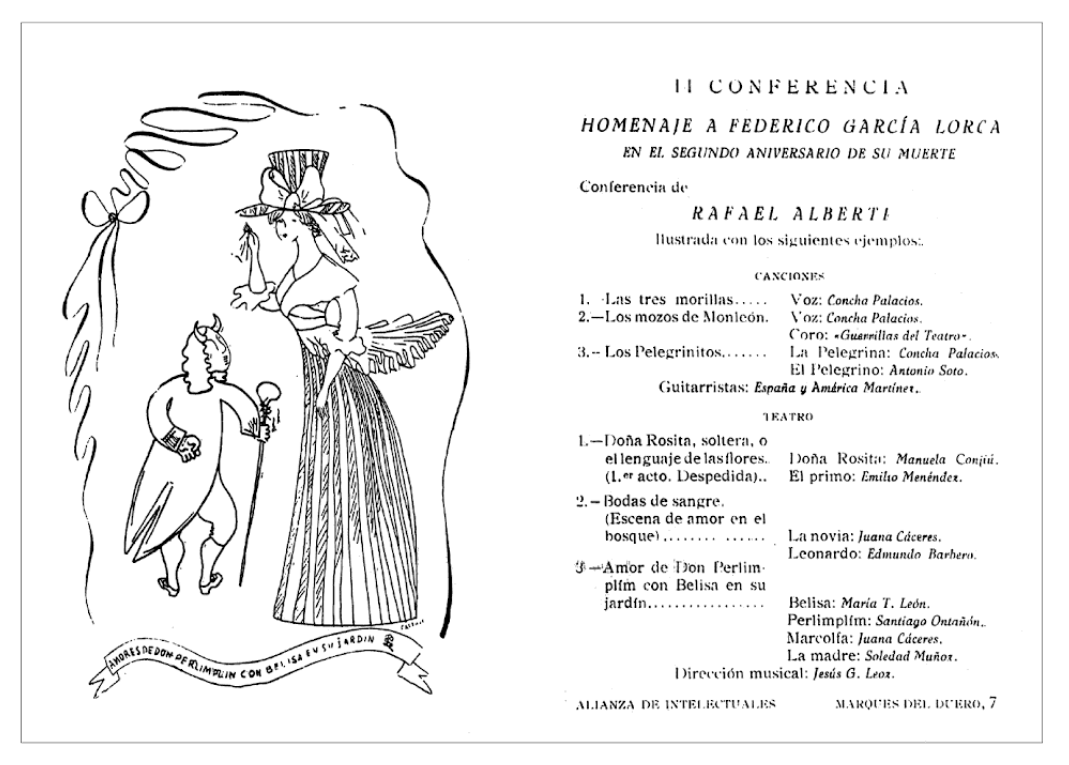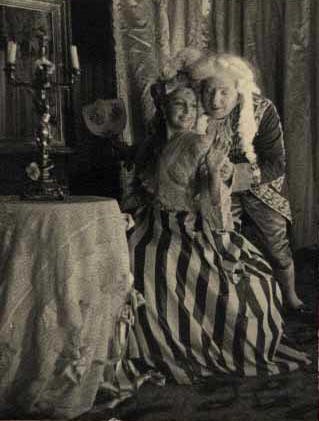
Amor de don Perlimplín con Belisa en su jardín (The Love of Don Perlimplín and Belisa in the garden. Erotic alleluia in four scenes (Chamber version) is a farce in which the grotesque constantly contrasts with the lyrical. It is told in four scenes.
The first introduces us to Don Perlimplín with his maid, Marcolfa. She convinces him that he should marry his neighbor Belisa. He proposes from the balcony and her mother accepts quickly, surely seduced by the financial situation of Don Perlimplín, although he is much older and the bride and groom do not love each other.
The second scene shows the wedding night. The protagonist falls in love with Belisa when he sees her naked through a slot in a door. Some goblins come out and hide the scene, the impotence of Don Perlimplín and Belisa’s infidelity. When the curtain that had hidden the scene is drawn back, the protagonist has large deer antlers on his head and the five balconies in the background are open. Although he realizes what has happened, he is happy to have fallen in love with Belisa.
In the third scene Perlimplín prepares the denouement with Marcolfa. Belisa is looking for a mysterious lover and her husband consoles her. Don Perlimplín encourages her to tell him her sorrows, tells her that he knows her lover, pretends he has just seen him and goes out after him.

In the fourth and last scene, the protagonist appears again with his maid Marcolfa preparing everything. He sends a note supposedly from the lover to Belisa to meet him in the courtyard at ten o’clock at night. Belisa goes, but he is not there. Perlimplín, when the agreed time comes, disappears behind the wall ready to kill him. Shortly afterwards, a mysterious man dressed in red enters the scene, with his face covered and a wound in his heart. He falls to the ground as Belisa’s mysterious lover. Belisa uncovers his face, discovering that Perlimplin was the man she had fallen in love with.
As the author informs to Fernández Almagro in a 1926 letter, his protagonist, Don Perlimplín, traditionally ugly and hunchbacked, comes from the “rough engravings and grotesque couplets” of an alleluia, or alleluias, from his childhood. It is also a variation on Cervantes’ theme of the young woman married to an old man (although Don Perlimplín is only fifty years old).

In 1928 Lorca agreed with Rivas Cherif to the performance of the play, by the Caracol group that he directed, in the Rex theater in Madrid. The Primo de Rivera dictatorship banned the play as immoral and in May 1929, in the middle of rehearsal, the police broke into the hall. The premiere was scheduled for February 5, 1929. The death of Queen María Cristina caused the suspension of all performances. That same day the police seized all copies of the play, prohibited its performance and closed the theater.
In the fall of 1932, Pura Maortua de Ucelay, director of the Club Teatral de Cultura Anfistora (a cultural theater association to which Lorca belonged and which he baptized with this name), managed to rescue a copy of the play and staged a performance on April 5, 1933 at the Teatro Español. It was preceded by The shoemaker’s prodigious wife. Lorca directed the rehearsals and staging.
Performers: Don Perlimplín: Santiago Ontañón; Belisa: Pilar de Bascarán; Marcolfa: Mrs. Domínguez; Belisa’s mother: Pilar Gracia; the elves: two children from a family very close to Lorca, Augusto and Andrés Higueras. Music by Scarlatti (all the intermissions were linked by Scarlatti’s sonatinas and the dialogues were constantly cut by chords and musical backgrounds), performed on the piano by Pura Lago, scenography by Ontañón and costumes by Pura Ucelay.
It will not be published in the author’s lifetime, although (as happens to him at other times) announced its imminent publication on more than one occasion, along with The Billy-Club Puppets.
There are three apographs of the work: the one Pura Maortua recovered from the censorship, heavily corrected by the poet; a copy of the previous one, with some errors, and a third copy made by Maortua for the Lorca family in the fifties. In addition, there are six fragments of handwritten autographs. The first edition will be that of the complete works published by Losada (Argentina) in 1938, edited by Guillermo de Torre (the second autograph follows). The next one, by Arturo del Hoyo in Aguilar, will be in 1954 (the second autograph follows, but corrects the first one). This edition was gradually increased, as the problems with Franco’s censorship were overcome. In 1968, Margarita Ucelay and Ernersto da Cal, in New York, London, Toronto, Holt, Rinehart and Winston, in a volume dedicated to 20th century Spanish Literature, will publish it again, following Ucelay’s first apograph.
It is one of Lorca’s farces, for people not puppets. It is considered one of his “experimental” or innovative pieces. It is a “chamber version” because later the author planned to develop the theme with all the complexity he perceived. In an interview that the author gives to Juan González Olmedilla, for El Heraldo de Madrid newspaper, one day before its premiere, on April 4, 1933, he speaks of the work for minorities as follows: “This ‘aleluya erótica’ (‘Erotic Alleluia’) is a tremendous work, which amuses me a lot. It is a theater of human monkeys, which begins in mockery and ends in tragedy. The hero, or anti-hero, who is made a cuckold, is Spanish and Calderonian; but he does not want to react Calderonianly, and hence his struggle, the grotesque tragedy of his case. I don’t know how a “chamber” public will receive my work; but I had a lot of fun when I was writing it and it makes me happy every time I read it or see it in a rehearsal.”
In 1923, possibly, Lorca began to devise this play. At the end of 1925, he seems to have it practically finished and in January 1926, he sends a part (second scene of the third act) to Melchor Fernández Almagro. It is a work that is, therefore, created in the years of the Residencia de Estudiants (under the influence of the avant-garde environment and friendship with Dalí) and summers in Asquerosa (Disgusting).
It seems that he worked on it during his visit to Dalí in Cadaqués in the spring of 1925. During the fall of 1925 and the first months of 1926, he also worked on it in Granada, where he felt trapped at the time, as he said in a letter to Fernández Almagro.
The source of this work, as with The Shoemaker’s Prodigious Wife, are those hallelujahs (religious songs) that the author claims to have known in his childhood, stories that were told from a paper where vignettes appeared that told a story through drawings and words. It was popular literature. Federico knew the alleluia of Don Perlimplín in his childhood in Fuente Vaqueros or in Asquerosa. He must have heard it sung or recited by some comedian or puppeteer who came to town.
On February 6, 1929, Federico García Lorca witnessed the police raid the theater, forbid the performance and take away all the copies of the play, which was filed in the Pornography section of the General Directorate of Security. This is how Margarita Ucelay told the scholar Miguel García-Posada. The author was left without text. He may have had to reconstruct it in New York where we know that he read the work several times to the public. This version has been lost, but not the English translation by Mildred Adams.
The play would not be performed again. It was not performed in commercial circuits in Spain until October 15, 1990 at the Teatro de Bellas Artes in Madrid (under the direction of José Luis Gómez).
Trailer of the performance (2016) by the Metatarso Contemporary Theater group.
Version: Alberto Conejero. Cast: Emilio Gavira, Olivia Delcán, Cristina Otero, Kees Harmsen/Peru Said Prez and Berta Ojea.
Direction: Darío Facal
Co-produced by Metatarso Producciones and Festival from Fall to Spring (Autonomous Community of Madrid).
Premiere: 2016 – La Abadia Theater.